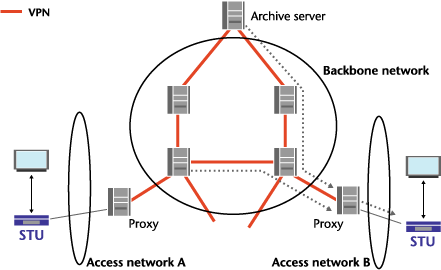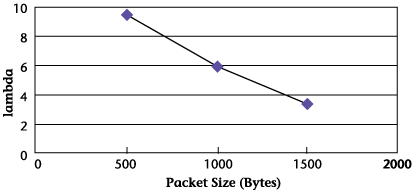|
Introduction
We are studying
a new VoD system
that can provide
TV programs to viewers
over a network.
The objective is
to let a viewer
watch his or her
favorite TV program
before or after
it is broadcast
to assist conventional
TV services. This
system is different
from the current
closed VoD system
that works over
cable networks or
in hotels in that
it uses a global
network architecture,
such as the Internet's,
to provide TV programs
to many viewers
throughout the country.
VoD system architecture
The
VoD system will
have a hierarchical
structure similar
to that of the Internet.
It will be necessary
to allocate proxies
for temporal storage
of the requested
programs and to
use Virtual Private
Networks (VPN) to
assure a sufficient
Quality of Service
(QoS) throughout
the network. The
VoD system architecture
shown in Figure
1 is composed of
an archive server,
proxies and set
top units (STU).
 |
| Figure
1: Example of
VoD system architecture |
Simulation
a. Simulation
software
We developed a piece
of simulation software
with the structure
shown in Figure
2. It works over
OPNET, which is
the most popular
network simulation
program and finds
the optimal resource
allocation.
The software will
be used to find
the optimal allocation
of proxies, their
buffer sizes, assignment
of bandwidth, and
other resources
in order to get
the desired QoS
expressed in terms
of parameters such
as delay and packet
loss.
The software has
the following features:
| - Real-time
Transport Protocol
(RTP) for transmission |
| - Real-Time
Streaming Protocol
(RTSP) for control
|
| - User Access
Model created
from actual
statistics |
| - Program
handlers at
the server for
virtual I/O |
| - Algorithms
(cache replacement,
cache routing,
Call Admission
Control (CAC),
etc.) can be
added. |
This software
can evaluate the
following items.
| i.
|
VPN
traffic profile
that includes
the VPN trunk
traffic parameters
and the requirements
for packet loss
and delay. |
| ii.
|
CAC & QoS.
CAC is a request
admission control
mechanism for
using resources
effectively.
QOS is the quality
provided by
the network.
It includes
service blocking
probability
(e.g. 1%) and
service response
delay. |
| iii.
|
Cache principle.
The program
distribution
between the
server and proxy
sites is very
important. The
capacity of
the cache buffer
is limited;
hence, the usage
of the cache,
such as the
decision as
to which files
to delete from
the cache, need
to be investigated.
|
| iv. |
RTP profile.
This includes
the packet size
and the synchronization
for the RTP
transmission.
It also includes
the transmission
mode. |
 |
| Figure
2: Structure
of the simulation
software for
the new VoD |
b. Results
(1) Effect of proxy
During the simulation,
the STU behavior
is approximated
by the user access
model, where the
request access rate
can be assumed to
be a Poisson distribution
and the user access
interval is approximated
by a pre-defined
probability distribution
obtained from data
provided by NHK.
The content preference
metric is approximated
by using a probability
distribution from
video shop statistics.
The proxy cache
performance is then
simulated for various
user parameters.
Figure 3 shows the
access rate's effect
on the number of
sessions over the
link between the
proxy and the archive.
The number of sessions
over the link depends
heavily on the access
behavior and the
number of program
handlers at the
proxy's site. Although
this is only a provisional
result given the
limited video resources,
it is clear that
this simulation
software can be
used to predicate
the system parameters
if it is given actual
video resource data.
 |
| Figure
3: Access rate's
effect on the
number of sessions |
(2) CAC
CAC decides whether
a connection request
can be accepted
or rejected. We
studied the Measurement
Based Call Admission
(MBCA) control method
with this software.
MBCA judges whether
it is possible to
permit a new connection
by using the current
packet delay and
the traffic parameters
to predict the packet
delay after adding
the new connection.
Until now, these
packet delays were
calculated using
an equation based
on the node analytic
model.
Figure 4 shows lambda
plotted against
packet length. Lambda
is the ratio of
the simulated value
to the value calculated
by the equation.
The results for
the simulation and
the calculation
are almost equal
when packet length
is long. However,
the value calculated
by the equation
is too large in
comparison with
the simulation value
when packet length
is short.
Thus, this simulation
software predicts
the system performance
more precisely in
the case of actual
packet sizes.
 |
| Figure 4: Result of MCBA
simulation |
Conclusion
The results of the
current simulation
are preliminary.
Still, it can analyze
the performance
of a VoD system
given practical
data. The simulation
software will be
expanded by adding
various optional
blocks to give a
more accurate and
realistic simulation.
These blocks include
algorithms for cache
replacement, cache
routing, and multicasting.
(Wang Kaiming, SARFT
(the State Administration
of Radio, Film,
and Television)
of China)
|

